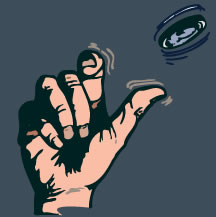Coin Flips in Poker Tournaments
 Coin flips are practically inevitable in an online No Limit Hold'em
tournament, however some players enter coin flips far too often and
wonder why they are not successful in tournament play. Although odds are
you will enter numerous coin flips in each tournament you play, it is
important to enter them in the most advantageous situations possible.
Coin flips are practically inevitable in an online No Limit Hold'em
tournament, however some players enter coin flips far too often and
wonder why they are not successful in tournament play. Although odds are
you will enter numerous coin flips in each tournament you play, it is
important to enter them in the most advantageous situations possible.
These situations include knocking a short stack out, doubling up when you are short-stacked, or battling for a big stack entering the late stages. Although many people seem to be thrilled when entering a coin flip situation, most observers get the wrong idea. Most people are thrilled to enter these situations simply because they are not behind. As each separate coin flip provides a 50/50 shot at winning the pot, the players are not thrilled to be ahead with a small pair vs. over-cards, but rather are thrilled to not be dominated.
Knocking Out Short Stacks
Your best opportunity out of the three scenarios discussed here, is always whenever you hold more chips than your opponent. This will automatically guarantee that you cannot be eliminated on the hand in which the coin flip is taking place. If you are fortunate enough to be sitting on a large stack entering the mid to late stages of a tournament, you will have various opportunities to enter pots with the short stacks who will continue to play aggressively.
These short stacks will be battling the blinds, and any stack under ten big blinds will most likely only be making one move: all-in. These short stacks will be pushing with very marginal hands, and sometimes you will have to make a decision with a marginal hand as well because you will not always have hands such as JJ, QQ, AK, KK or AA that are an easy call. Some of the marginal hands you may be considering calling with when you have a short stack covered may be A10, KQ, KJ, 44, 55, or 66. If you are considering calling, make sure to think about a few things:
You must first consider the short stack's position, if he or she sits in early position you may wish to fold these semi-strong hands, and stick with pairs above 88, and AQ or AK. If the short stack pushes in very late position you will have no trouble calling his or her all-in with the six hands listed above. If you are sitting in the big blind and the raiser has only four to five big blinds, you also can consider a call with an even weaker hand such as K10, A9, or 33, simply because you are getting 2:1 on your money.
Pushing as a Short Stack
Short stacks are pressured by the blinds to push all-in very often as the blinds increase. This is another case when you may have to enter a coin flip situation because you will be called by a larger stack attempting to knock you out. If you hold around ten big blinds with one of the six hands listed above, your all-in is a strong move because you force the remaining players at the table to have a big hand, especially if you push in early position.
If you shove all-in and the players do not hold JJ, QQ, KK, AA, AK or AQ, you will most likely be entering a coin flip situation, which is the best situation you can hope for. In this case you have the opportunity to double up to nearly an average stack, and enter the later rounds with a strong chance to survive. You may even have the other player dominated if they have a lower pocket pair or two weak face cards.
As a short stack, you can push with weaker and weaker hands while in late position. If everyone in front of you folds, you should be pushing any pocket pair and any two decent face cards. By pushing all-in, you put the other players in a tough spot, because it is unlikely they have premium hands.
Re-Raising Big Stacks
Another opportunity you may have in the late stages of tournaments to make a move may be while you hold a large stack. At this point the blinds will be fairly large, and the larger stacks are going to be pressuring the blinds, and hoping to steal them very often. These raises often occur in late position and can be made with any two cards.
If you are sitting in a blind or dealer position with a large stack directly in front of you, you have the opportunity to re-raise the big stack's pre-flop raise. The big stack is almost surely stealing the blinds, and therefore a hand such as A9, A10, KQ, KJ, and pair above 44 are worth a re-raise. The big stack will almost always recognized he or she is far behind and surrender the hand immediately, awarding you the blinds and raise for a simple play.
